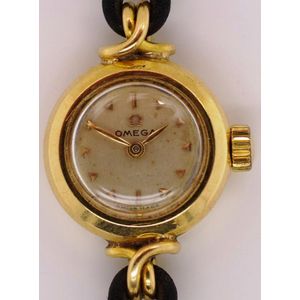Victorian Japanned Clock with French Movement and Bracket
You must be a subscriber, and be logged in to view price and dealer details.
Subscribe Now to view actual auction price for this item
When you subscribe, you have the option of setting the currency in which to display prices to $Au, $US, $NZ or Stg.
- Pendulum - The pendulum was discovered around 1602 by Galileo Galilei, and was adopted for time keeping by the Dutch mathematician and natural philosopher, Christiaan Huygens, who excelled in astronomy, physics, and horology.
The pendulum comprises a metal rod usually of brass or steel with a metal disk, known as a bob, at the end. The movement of the pendulum is driven by weights or a spring, and as a pendulum swings in a regular arc, it was found accuracy could be controlled to within a few seconds a week.
Timekeeping can be adjusted by changing the height of the bob on the rod, making the pendulum either swing slower or faster.
The disadvantage of the pendulum was that changes in temperature also changed the length of the pendulum, interfering with the accuracy of the clock, and so in the 18th century two types of mercurial pendulums were invented which countered the movement in the steel rod.
The pendulum was the world's most accurate timekeeping technology until the invention of the quartz clock, regulated by a quartz crystal, in 1927. - Circa - A Latin term meaning 'about', often used in the antique trade to give an approximate date for the piece, usually considered to be five years on either side of the circa year. Thus, circa 1900 means the piece was made about 1900, probably between 1895 and 1905. The expression is sometimes abbreviated to c.1900.
- Movement - The technical name for the workings of a clock or watch, and does not include the dial or case.
- Japanning - Japanning is the early eighteenth century technique used by European craftsmen to imitate the oriental style lacquer work that became popular in England, France, the Netherlands, and Spain in the 17th century.
The lacquer used was based on the lac beetle dissolved in alcohol (as used in French polish) and differed from the Chinese lacquer which was based on tree sap.
Each layer of the lacquer was allowed to dry and then sanded down. It was applied over cream, yellow, green, red, or black grounds. Japanning using gold leaf was also widely used with lacquer work. The technique can be found on bureaux, cabinets, chests, longcase clocks, and chairs. - Victorian Period - The Victorian period of furniture and decorative arts design covers the reign of Queen Victoria from 1837 to 1901. There was not one dominant style of furniture in the Victorian period. Designers used and modified many historical styles such as Gothic, Tudor, Elizabethan, English Rococo, Neoclassical and others, although use of some styles, such as English Rococo and Gothic tended to dominate the furniture manufacture of the period.
The Victorian period was preceded by the Regency and William IV periods, and followed by the Edwardian period, named for Edward VII (1841 ? 1910) who was King of the United Kingdom and the British Dominions and Emperor of India for the brief period from 1901 until his death in 1910.
This item has been included into following indexes:
Visually similar items

An impressive Louis XV style marble top circular table with decorative ormolu mounts. Height: 82 cm, diameter: 83 cm

A Chinese cloisonne enamel gilt bronze three footed censer with four character mark to base, height 49.5 cm

Vintage Omega ladies cocktail watch in a 18ct gold watch case, with mineral glass. Manual wind movement was working when tested. Approx 16 mm diameter case ex crown

French cavalry sword with scabbard. Curved single edged blade with one broad fuller and one subsidiary fuller. Embossed brass guard, wire bound leather grip. Heavy steel scabbard, approx 104 cm long
